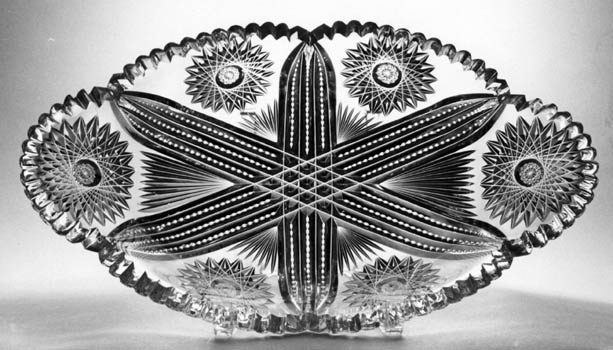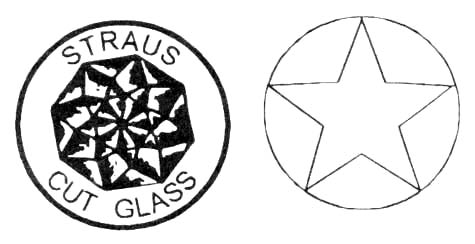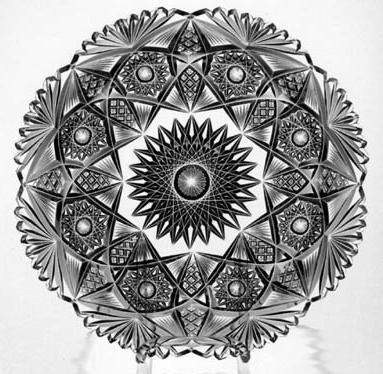L. Straus & Sons
American Brilliant Glass Education and Research - HBG
The Santa Maria Pattern Cut by L. Straus & Sons
The pattern on this ice cream tray, Santa Maria, made its debut at the 1893 World’s Columbian Exposition, held in Chicago to commemorate the four hundredth anniversary of the discovery of the New World. It is shown in the 1893 L. Straus & Sons catalog where the shape of this tray is given as no. 442. The Santa Maria pattern was never patented. L = 16.25″ (41.3 cm), W = 9.25″ (23.5 cm), h = 2.25 (5.7 cm), wt = 8 lb (3.6 kg). Sold for $500 in 1990.

Historical Sketch, Trademark, and Catalogs
Lazarus Straus immigrated to this country from Germany (Bavaria) in 1852 and established a “business of importing and selling fine china and glassware” (Revi 1965, pp. 112-113). In 1874 he and his sons, Isidor and Nathan, leased the china and glass shop in the R. H. Macy department store, New York City. Two years previously their family business had become known as L. Straus & Sons. Sometime after 1874 the Strauses acquired a financial interest in Macy’s (note 1).
Although L. Straus & Sons had operated a cutting shop in the Macy department store as early as 1880, in 1888 the company established a second shop (and showroom) at 44 Warren St. “to avoid a potential conflict of interest because of their partial ownership in Macy’s”. The cutting operations at the department store continued after 1888 and after Macy’s moved, in 1902, from its original location on 14th St. to its present site, Broadway at Sixth Ave (Herald’s Square). Initially the cut glass sold at Macy’s was not identified as Straus cut glass. In 1885 the American Institute awarded a diploma and “medal of superiority” to R. H Macy & Co. “for cut and engraved glass ware” with no mention of L. Straus & Sons. The cut glass sold by the store probably was first identified as “Straus cut glass” when the Straus family acquired full ownership of the store in 1896. Subsequently, Macy’s identified much of its cut glass as “Straus cut glass” in its catalogs until at least 1912.
During the 1890s and the early years of the twentieth century L. Straus & Sons produced a great quantity of cut glass at various locations. It was displayed at the Warren St. establishment which eventually was expanded to include 42, 46, and 48 Warren St. as well as a connecting store at 116 Chambers St. At one time the company had branch offices in London, Paris, Berlin, and Yokohama.
Although the company’s first cutting shop was located in Warren St., a larger facility was soon required and, in 1889, a new cutting shop was established at 14 Jay St. The extensive display of cut glass produced by L. Straus & Sons for the Columbia Exposition in 1893 was made here. The following year the company’s need for still larger quarters became apparent. This resulted in the construction of a new factory in Hoboken, NJ. Its capacity was twice that of the old Jay St. cutting shop. In fact, it claimed to be “the largest glass cutting establishment in one space in the world”. The extensive line of products made at the Jay St. factory continued to be made in Hoboken and, in addition, there were foreign commissions. Unfortunately the Hoboken factory was destroyed by fire in 1897, necessitating the establishment of a new cutting shop. This one was located on W. 59th St., NYC, but it too was destroyed by fire seven years later, in 1904. Craig Carlson has related the subsequent history of the company as follows:
Within three weeks a new factory opened on Thirty-sixth Street and North River where [it] remained until August of 1905. The cutting operation then moved to 794-800 Tenth Avenue near 54th Street. Once again fire completely destroyed the Tenth Avenue cutting shop on March 1, 1912, and the cutting operation was moved to Debrosses, Vestry and Greenwich Streets. The last ad found, to date, giving this factory location [can be found] in the December 18, 1919 [issue of] Crockery and Glass Journal.
L. Straus & Sons produced cut glass of high quality from its earliest years until about 1904 when the company began to use “figured” blanks, at least to some extent, in order to reduce costs. At an as-yet undetermined date, Straus also began to use chemical (acid) polishing, an additional cost-cutting procedure. But as early as 1896 the company’s ads had warned against the acid polish with the following statement:
We do not cheapen the finish of our Cut Glass by using Chemicals. The use of the old time polishing wheels and buffs is a more costly process but it produces a lasting brilliancy and not a mere temporary gloss. All Straus Cut Glass [is] finished and polished by hand only.
When, in 1897, a new pattern, Wales, was introduced, the company boasted that the pattern “has no trite or antiquated features like Strawberry Diamonds [i.e., cross-cut diamonds] or Fan edge.” This design philosophy — which was shared to some extent by other companies as well — can also be seen in the patterns Straus patented at this time. The Napoleon and Talisman patterns of 1895 were the last patents to use the cross-cut diamond motif and the fan-edge style to any extent. Another change in the company’s design philosophy occurred about 1910 when exclusively “rich-cut” patterns were replaced by patented patterns that included realistic engravings, mainly of flowers.
“Figured” blanks and acid polishing, as well as some of the realistic patterns, can combine to discourage today’s collector who wishes to add L. Straus & Sons cut glass to his or her collection. When these cheaper products are found one needs to remind oneself that high quality cut glass made by this company during the nineteenth century is still available, although it often is not recognized and marketed as Straus cut glass.
Principal sources: catalogs listed below
Rose bowl cut in the Venetian pattern, the first pattern patented by L. Straus & Sons. Designed by Benjamin Davies, it was patented on 11 Dec 1888. D = 8″ (20.3 cm), H = 7″ (17.8 cm), wt = 5.5 lb (2.5 kg). Sold for $475 in 1988.

Trademark
The only trademark in use by L. Straus & Sons during the brilliant period of American cut glass is the one shown on the left, below. It is easy to see how this mark, which was used only on paper labels, was erroneously interpreted by early investigators as having been simplified for use as the acid-etched star-in-a-circle trademark shown on the right. This latter trademark, however, was, in fact, registered by the Libbey Glass Company in 1901. It was used only on plain blanks that Libbey sold to various cutting shops, including — at least occasionally — L. Straus & Sons. As a result, pieces cut by Straus can sometimes be found with the star-in-a-circle trademark. The vast majority of Straus cut glass, however, is unmarked. Therefore, when the star-in-circle trademark is found on cut glass, there is an excellent chance that the cutting was not made by L. Straus & Sons. Identification of authentic Straus cut glass is made by referring to the two catalogs listed below and to the patent drawings found in Revi (1965, pp. 112-123) and at the USPTO Web site.

Celery tray in the Imperial pattern, the second pattern patented by L. Straus & Sons, cut on shape no. 233. Designed by Hermann Siegel and patented in 1892. L = 11.25″ (28.6 cm), W = 4.5″ (11.4 cm), wt = 2.75 lb (1.2 kg). Sold for $175 in 1990.

Catalogs
-- 1893: L. STRAUS & SONS. A catalog, with no original prices, reprinted by the American Cut Glass Association in co-operation with the Smithsonian Institution Libraries. 1987, v + 37 pp.
-- 1884-1911: STRAUS — MACY, RICH CUT GLASS CATALOG. A collection of patterns and shapes as they appeared in contemporary trade journals and in catalogs issued by R. H. Macy & Co., the latter with original prices. Published by the American Cut Glass Association. 2000, xxxiv + 134 pp.
Salad bowl in the Capri pattern, the third pattern patented by L. Straus & Sons, cut on shape no. 164. Designed by Benjamin Davies and patented in 1893. D = 9″D (22.9 cm), H = 3″ (7.6 cm), wt = 4 lb (1.8 kg). Sold for $175 in 1993.

NOTE:
1. See Carlson, C.E., 2000: The Macy — Straus cut glass connection, in STRAUS — MACY, RICH CUT CATALOG (American Cut Glass Association, pp. vii – xii) for the direct quotations given in this Historical Sketch, as well as for factual material concerning the cut-glass operations of L. Straus & Sons.
The AMERICAN NATIONAL BIBLIOGRAPHY (Oxford University Press, 1999) contains excellent, up-to-date biographical information on the Straus family by Susan Hamburger (see entry for Isidor Straus, Vol. 21, pp. 6-7).
The Patented Patterns (1888-1917)
This compilation is largely based on the J. Stanley Brothers, Jr. volumes of patented material on file at the Rakow Library of the Corning Museum of Glass as well as the U. S. Patent and Trademark Office’s Web site, together with a reprinted Straus catalog from 1893 and a composite catalog, STRAUS — MACY RICH CUT CATALOG, both published by the American Cut Glass Association. Revi’s early work (1965, pp. 112-123) has also been useful. Craig Carlson has examined trade journals from the period when L. Straus & Sons was active, and he has kindly provided data that have been included in this table. Names within quotation marks — “coined” names — should no longer be used when official factory names become known, but because several of the catalog names listed here may be new to many readers their “coined” names are also given, where known.
According to the 1893 Straus catalog patents were “applied for” for the Isabella, LaRabida, and Granada patterns, but the actual patents have not been found. Perhaps the applications were rejected by the Patent Office. Also, some investigators have interpreted Revi’s remarks on pp. 112-113 of his book (Revi 1965) as an indication that the Americus, Electra (“Ulysses”), and Peerless patterns (all shown in the 1893 catalog) were also patented, but no evidence has been found to support this contention.
All patents were assigned by their patentees to the company, except those marked with an asterisk (*). These patents were retained by the patentee, Hermann Siegel.
Patent No. / Catalog (“Coined” Name) / Patentee / Application Filed / Date Granted
18,791 / Venetian (“Encore”) / Benjamin Davies / 22 Oct 1888 / 11 Dec 1888
21,333 / Imperial / Hermann Siegel / 4 Jan 1892 / 2 Feb 1892 (*)
22,286 / Capri (“Inverted Kite”) / Benjamin Davies / 1 Feb 1893 / 14 Mar 1893
23,252 / Brazilian (“Golden Wedding”) / Benjamin Davies / 5 Apr 1894 / 8 May 1894
23,253 / Columbus (“Tausend”) / Benjamin Davies / 5 Apr 1894 / 8 May 1894
23,254 / San Salvador (“Tassel”) / Benjamin Davies / 5 Apr 1894 / 8 May 1894
23,727 / Majestic (“Athena”) / Hermann Siegel / 24 Sep 1894 / 23 Oct 1894 (*)
24,202 / Napoleon (“Perrot”) / Benjamin Davies / 20 Mar 1895 / 16 Apr 1895
24,355 / Talisman (“Bontemps”) / Benjamin Davies / 20 Mar 1895 / 4 Jun 1895
26,190 / American Beauty (“Sterling”) / Benjamin Davies / 5 Sep 1896 / 13 Oct 1896
28,733 / “Puntie” / Benjamin Davies / 28 Mar 1898 / 31 May 1898
31,738 / Planeta (“Bijoux”) / Benjamin Davies / 29 Sep 1899 / 31 Oct 1899
35,323 / Richmond (“Drape”, “Stars and Banners”) / Herman Richman / 1 Oct 1901 / 26 Nov 1901
37,225 / “Beatrice” / Herman Richman / 12 Oct 1904 / 15 Nov 1904
37,353 / “Joan” / Hermann Siegel / 27 Jan 1905 / 28 Feb 1905 (*)
37,389 / “Avon” / William R. Schaffer / 23 Feb 1905 / 4 Apr 1905
37,999 / “Turandot” / Benjamin Davies / 15 Mar 1906 / 8 May 1906
38,615 / “Manon” / Herman Richman / 16 May 1907 / 11 Jun 1907
40,742 / “Daisy and Button with Roses” / Benjamin Davies / 20 Apr 1910 / 28 Jun 1910
49,805 / “Daisies and Diamonds” / Herman Richman / 25 Aug 1916 / 24 Oct 1916
49,806 / R1529 (“Carnations and Diamonds”) / Herman Richman / 30 Aug 1916 / 24 Oct 1916
49,807 / “Songbird with Flowers” / Herman Richman / 30 Aug 1916 / 24 Oct 1916
51,028 / Adam (“Festoon and Urn”, “Urn and Daisy”) / Herman Richman / 5 May 1917 / 10 Jul 1917
51,029 / Late Georgian (“Maltese Urn”) / Herman Richman / 5 May 1917 / 10 Jul 1917
51,030 / Late Colonial (“Festoon and Wild Rose”) / Herman Richman / 5 May 1917 / 10 Jul 1917
51,080 / Velvet (“Lily of the Valley and Pansy”) / Herman Richman / 27 Feb 1917 / 24 Jul 1917
The Patented Napoleon Pattern by L. Straus & Sons
Plate cut in the Napoleon pattern. Designed by Benjamin Davies for L. Straus & Sons as patent no. 24,202 which was granted on 16 Apr 1895. D = 9″ (22.9 cm), wt = 1.5 lb (0.7 kg). Sold for $175 in 1988.

Note from webmaster: There are some remaining writings on Straus by Craig Carlson, known for his scholarship on Straus. I am attempting to assemble these into a single section and it will be added to this area of the Brilliant Glass Education-HBG section when ready.
Content courtesy of Warren and Teddie Biden and Jim Havens